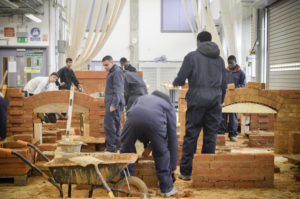
Wayne Lysaght-Mason, Managing Director at IronmongeryDirect, takes a look at the rate in which demand for construction workers is rising, and discusses how people can be attracted into the sector.
Growth within the house-building sector is quickly rising, particularly as the Government tries to combat the current housing crisis in the UK. It has promised a £1.2 billion investment to build 200,000 new homes over the next four years. But with the construction industry facing its biggest skills shortage in almost 20 years, could building projects experience significant delays?
 During the 2008 economic crisis, the primary concern for much of the construction sector was staying afloat and keeping out of the red. As a result, many jobs were sacrificed and firms found themselves having to let experienced staff members go in order to survive. In fact, between 2008 and 2010, 300,000 tradespeople were forced to leave the industry and look for work in other professions.
During the 2008 economic crisis, the primary concern for much of the construction sector was staying afloat and keeping out of the red. As a result, many jobs were sacrificed and firms found themselves having to let experienced staff members go in order to survive. In fact, between 2008 and 2010, 300,000 tradespeople were forced to leave the industry and look for work in other professions.
Fast forward eight years and the economy is now gaining strength. According to IronmongeryDirect’s Annual Industry Review, revenues and workloads are on the up, and in 2015 the construction sector appeared to occupy a positive position. Over half of tradespeople surveyed described themselves as very busy throughout 2015, and 45% had so much work on they even had to turn jobs away. But with work coming in thick and fast, the industry is starting to feel the effects of having lost so much of its talent to the recession.
Shortage of skilled trades
The biggest shortage of skilled workers can be seen when it comes to recruiting bricklayers. The Construction Industry Training Board (CITB) predicts that 2,800 bricklayers will be needed each year by 2020 in order to keep up with the rise in workload, but over half of construction firms have cited this type of worker as the most difficult to source.
Across the whole sector, 224,000 new roles will need filling over the next four years to meet the increasing demand. Yet, with over a quarter of construction companies struggling to recruit new staff in 2015, it’s feared there will not be enough skilled people to carry out the work. And without the necessary workers, growth in the sector is likely to be severely stunted with efforts to overcome the housing-crisis facing serious delays.
Attract younger people
To bridge the skills gap and support sustainable growth within the construction industry, immediate action needs to be taken. With over 622,000 16-24 year olds currently looking for work,attracting new talent to the building trade would be a good place to start. Particularly as there is a lack of young people entering the sector at present. To combat this, more needs to be done to make a career in construction appeal to the younger generation.
One way could be for schools to work closely with the building sector: inviting firms in to host talks on the benefits of taking up a trade, the valuable skills that can be gained, and the types of jobs available. Creating more training and apprenticeship opportunities is also another effective option, giving young people the chance to receive hands-on, real life work experience.
Retain skilled workers
As training the next generation of skilled workers takes time, it’s just as important to take care of those already working in the trade sector. Ensuring existing employees are happy and motivated will go a long way when encouraging them to remain within the industry. Staff members are more likely to stay with a company that supports their development and career progression and makes them feel valued. Offering the right benefits, such as regular training and rewards for hard work, will help to keep employees engaged so they remain loyal to the firm.
 Without the required workforce to keep up with rising demand, vital house building projects may be put at risk and growth in the sector could be stopped in its tracks. With the shortage the worst it’s been since 1998, the issue cannot be ignored and must be addressed immediately to aid the industry’s recovery. Now is the time to focus on investment in skills and talent to ensure all 224,000 job vacancies can be filled by 2020.
Without the required workforce to keep up with rising demand, vital house building projects may be put at risk and growth in the sector could be stopped in its tracks. With the shortage the worst it’s been since 1998, the issue cannot be ignored and must be addressed immediately to aid the industry’s recovery. Now is the time to focus on investment in skills and talent to ensure all 224,000 job vacancies can be filled by 2020.
Statistics are drawn from the Ironmongery Direct industry review: See www.IronmongeryDirect.co.uk/industry-review for more details.








